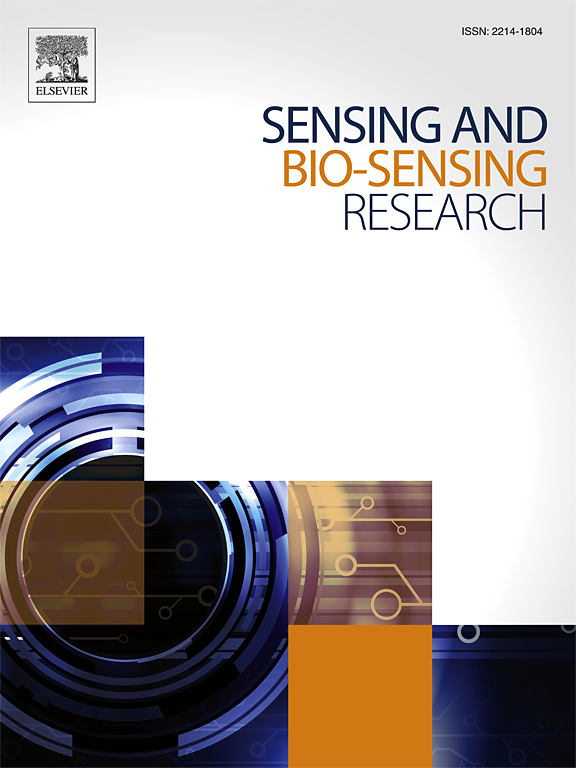同时检测水中4-氨基酚和扑热息痛的环保、高性价比电化学传感器的研制
IF 4.9
Q1 CHEMISTRY, ANALYTICAL
引用次数: 0
摘要
由于其持久性和对水生生态系统的潜在不利影响,制药废物污染日益成为环境问题。在这些污染物中,扑热息痛(PA)和4-氨基酚(4-AP)因其广泛使用而在城市废水中普遍存在。准确检测这些化合物对于环境风险评估和缓解战略至关重要。在本研究中,开发了一种基于功能化碳纳米纤维(CNF-COOH)修饰的碳丝网印刷电极(c - spe)的电化学传感器,用于同时检测PA和4-AP。对市售的金基和碳基spe的电化学性能进行了评价,表明c - spe对PA和4-AP的灵敏度更高。CNF-COOH的掺入改善了电子转移和增加了表面积,通过促进与目标分析物更强的相互作用提高了灵敏度和选择性。新型C-SPE/CNF-COOH传感器对PA的检测限为0.002 mM,对4-AP的检测限为0.007 mM。它在真实的淡水样品中成功地进行了测试,即使在复杂的基质中也显示出很高的准确性。这种创新的方法为药物污染物的常规监测提供了一种快速、经济、便携的分析工具,使环境风险评估更加准确,并支持实施更有效的管理策略。本文章由计算机程序翻译,如有差异,请以英文原文为准。
Development of eco-friendly and cost-effective electrochemical sensor for the simultaneous detection of 4-aminophenol and paracetamol in water
Pharmaceutical waste contamination is an increasing environmental concern due to its persistence and potential adverse impact on aquatic ecosystems. Among these contaminants, paracetamol (PA) and 4-aminophenol (4-AP) are prevalent in urban wastewater due to their widespread use. Accurate detection of these compounds is essential for environmental risk assessment and mitigation strategies. In this study, an electrochemical sensor based on carbon screen-printed electrodes (C-SPEs) modified with functionalized carbon nanofibers (CNF-COOH) was developed for the simultaneous detection of PA and 4-AP. The electrochemical performance of commercially available gold and carbon-based SPEs was evaluated, demonstrating superior sensitivity for PA and 4-AP with C-SPEs. The incorporation of CNF-COOH improved electron transfer and increased surface area, enhancing both sensitivity and selectivity by facilitating stronger interactions with the target analytes. The novel C-SPE/CNF-COOH sensor achieved detection limits of 0.002 mM for PA and 0.007 mM for 4-AP. It was successfully tested in real freshwater samples, demonstrating high accuracy even in complex matrices. This innovative methodology provides a rapid, cost-effective, and portable analytical tool for routine monitoring of pharmaceutical contaminants, enabling more accurate environmental risk assessments and supporting the implementation of more efficient management strategies.
求助全文
通过发布文献求助,成功后即可免费获取论文全文。
去求助
来源期刊

Sensing and Bio-Sensing Research
Engineering-Electrical and Electronic Engineering
CiteScore
10.70
自引率
3.80%
发文量
68
审稿时长
87 days
期刊介绍:
Sensing and Bio-Sensing Research is an open access journal dedicated to the research, design, development, and application of bio-sensing and sensing technologies. The editors will accept research papers, reviews, field trials, and validation studies that are of significant relevance. These submissions should describe new concepts, enhance understanding of the field, or offer insights into the practical application, manufacturing, and commercialization of bio-sensing and sensing technologies.
The journal covers a wide range of topics, including sensing principles and mechanisms, new materials development for transducers and recognition components, fabrication technology, and various types of sensors such as optical, electrochemical, mass-sensitive, gas, biosensors, and more. It also includes environmental, process control, and biomedical applications, signal processing, chemometrics, optoelectronic, mechanical, thermal, and magnetic sensors, as well as interface electronics. Additionally, it covers sensor systems and applications, µTAS (Micro Total Analysis Systems), development of solid-state devices for transducing physical signals, and analytical devices incorporating biological materials.
 求助内容:
求助内容: 应助结果提醒方式:
应助结果提醒方式:


